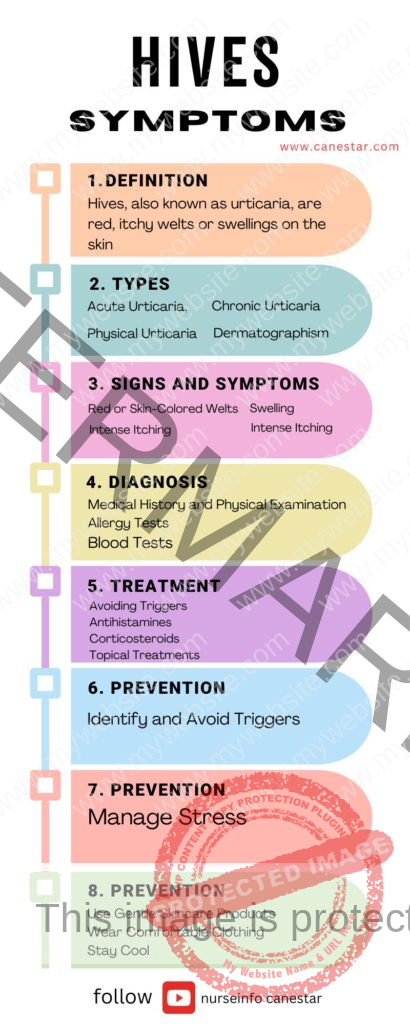HIVES (Urticaria) SYMPTOMS – Definition, types, signs and symptoms, diagnosis, treatment
HIVES (Urticaria) SYMPTOMS – Definition, types, signs and symptoms, diagnosis, treatment
Hives (Urticaria)
Definition
Hives, also known as urticaria, are red, itchy welts or swellings on the skin. They can vary in size and appear anywhere on the body. The welts can coalesce to form larger areas of raised skin and can be short-lived (acute) or long-lasting (chronic).
Types
- Acute Urticaria: Lasts less than six weeks. Commonly triggered by infections, foods, medications, insect stings, or environmental factors.
- Chronic Urticaria: Lasts longer than six weeks. Often idiopathic (unknown cause) but can be associated with autoimmune disorders, chronic infections, or other underlying health issues.
- Physical Urticaria: Triggered by physical stimuli such as pressure, cold, heat, exercise, sunlight, or water.
- Dermatographism: A type of physical urticaria where welts form in response to stroking or scratching the skin.
Signs and Symptoms
- Red or Skin-Colored Welts: Vary in size, from small spots to large patches.
- Intense Itching: Can be severe and distressing.
- Swelling: Can occur in the deeper layers of the skin (angioedema), commonly affecting the lips, eyelids, and throat.
- Welts That Change Shape and Move: Can disappear and reappear within minutes or hours.
- Pain or Stinging: In cases with more severe swelling or pressure.
Diagnosis
- Medical History and Physical Examination: Initial assessment includes a detailed history of symptoms, potential triggers, and physical examination of the hives.
- Allergy Tests: Skin prick tests or blood tests to identify specific allergens if an allergic reaction is suspected.
- Blood Tests: To check for underlying conditions like autoimmune disorders or infections.
- Skin Biopsy: Rarely needed but may be performed to rule out other conditions.
Treatment
- Avoiding Triggers: Identification and avoidance of known triggers is crucial.
- Antihistamines: Over-the-counter or prescription antihistamines to reduce itching and swelling.
Examples: Cetirizine, loratadine, diphenhydramine.
- Corticosteroids: For severe cases, short-term use of oral corticosteroids (e.g., prednisone) may be necessary.
- Medications for Chronic Urticaria:
Omalizumab: A monoclonal antibody used for chronic idiopathic urticaria.
Leukotriene Receptor Antagonists: Sometimes used in combination with antihistamines.
- Topical Treatments: Creams or ointments to soothe itching (limited effectiveness for hives).
- Emergency Treatment: For severe reactions involving breathing difficulties, an epinephrine injection (EpiPen) and immediate medical attention are required.
Prevention
Prevention of Hives (Urticaria)
- Identify and Avoid Triggers:
Keep a diary to track foods, medications, and activities that may trigger hives.
Avoid known allergens, such as certain foods (e.g., shellfish, nuts), medications (e.g., antibiotics, aspirin), and insect stings.
- Manage Stress:
Practice relaxation techniques such as deep breathing, meditation, or yoga to reduce stress, which can be a trigger for hives.
- Use Gentle Skincare Products:
Opt for hypoallergenic and fragrance-free skincare products to minimize skin irritation.
- Wear Comfortable Clothing:
Choose loose-fitting clothes made of soft, breathable fabrics like cotton to avoid skin irritation.
- Stay Cool:
Avoid excessive heat and sweating by staying in a cool environment and wearing lightweight clothing.
- Take Preventive Antihistamines:
In cases of chronic urticaria, taking a daily non-drowsy antihistamine may help prevent outbreaks.
- Protect Against Infections:
Follow good hygiene practices and get timely vaccinations to prevent infections that can trigger hives.
- Regular Medical Check-ups:
For those with chronic hives or underlying health conditions, regular visits to a healthcare provider can help manage and prevent episodes.
Effective management of hives involves both treating the symptoms and addressing any underlying causes or triggers. For chronic or severe cases, consultation with a specialist, such as an allergist or dermatologist, may be necessary.


